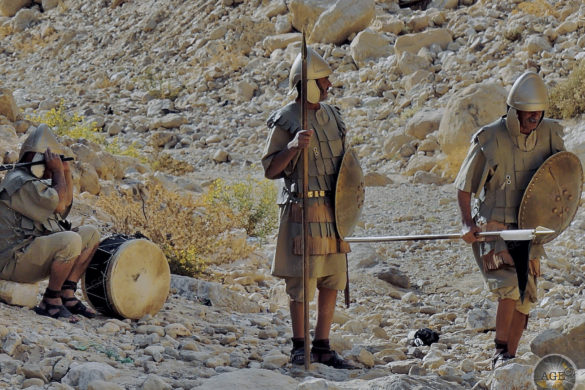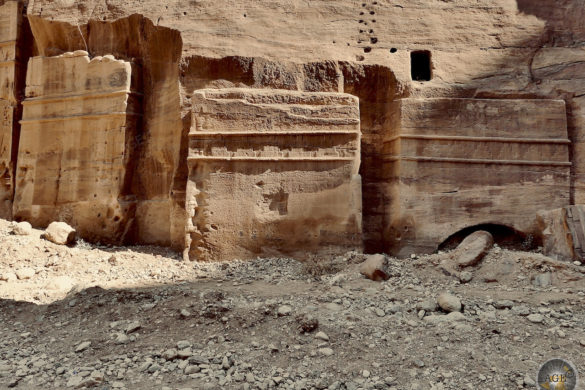Jordan • World Heritage Petra • History of Petra • Petra map • Sightseeing Petra • Rock tombs Petra
The origin and beginning
The Nabataeans came from the interior of Arabia. The Nabataean Empire was the first Arab empire in history. Little is known about the origins of this people and there are various theories. They probably settled in the 6th century BC. The area around Petra and displaced the tribe that had previously lived there. At first they lived as semi-nomads with tents in the protected Petras valley. A first historically documented note about the Nabbeans was not found until 311 BC. In Greek history.
The rise to a commercial metropolis
The city owes its rise to its importance as a trading center. For 800 years - from the 5th century BC BC to the 3rd century AD - the ancient city was an important hub for traders. Petra was strategically located and became a popular stop on numerous caravan routes. The traders traveled between Egypt and Syria or from southern Arabia to the Mediterranean. All roads led through Petra. The Nabatean region is considered to be the crossroads between Weihrauchstrasse and Königsweg. The city became an intermediate trading center for luxury goods such as spices, myrrh and frankincense and came about as early as the 4th century BC. To considerable prosperity.
The probation
In the 3rd century BC The Nabataeans were able to repel an attack on Petra. One of the successors of Alexander the Great tried to take the city, which had become famous for its wealth. His army was able to sack the city, but was caught and defeated by the Nabataeans on the way back in the desert.
The heyday of Petra
In the 2nd century BC In BC Petra developed from a nomadic trading base to a permanent settlement and became the capital of the Nabateans. Fixed structures were erected, which over the years assumed ever greater dimensions. Around 150 BC Chr the Nabataean Empire expanded its influence towards Syria. In the 80s of the 1st century BC The Nabateans ruled under King Aretas III. Damascus. Petra also flourished during this marriage of Nabatean history. Most of the city's rock tombs were built in the late 1st century BC. BC and in the early 1st century AD
The beginning of the end
In the 1st century BC The Nabataeans supported the rightful heir of the throne of Judea and drove his brother to Jerusalem, where they besieged him. The Romans ended this siege. They asked the king of the Nabataeans to withdraw immediately, otherwise he would be declared an enemy of Rome. 63 BC Then Petra had to put herself in the service of Rome. The Nabataeans became Roman vassals. Nevertheless, King Aretas managed to preserve his kingdom for the time being and Petra remained autonomous for the time being. During the lifetime of Christ, the rock city probably had around 20.000 to 30.000 inhabitants.
Under Roman rule
The Romans increasingly diverted the old trade routes, so that the city lost more and more influence and was robbed of the source of its wealth. The last king of the Nabataeans finally denied Petra the title of capital and moved it to Bostra in what is now Syria. In AD 106, Petra was finally incorporated into the Roman Empire and was henceforth run as the Roman province of Arabia Petraea. Although Petra had lost influence and prosperity, it remained settled. The city experienced a brief second high as the bishopric and capital of a Roman province. The remains of several testify to this Churches of the Rock City from late antiquity, which can be found in the valley of Petra.
Abandoned, forgotten and found again
Severe earthquakes destroyed some buildings in the rock city of Petra. In particular, there was severe destruction in AD 363. Petra was gradually abandoned and only visited by Bedouins for a short rest. Then the city fell into oblivion. It was only 400 years ago that the B'doul tribe moved back into the Petras caves permanently. For Europe, the lost city was not rediscovered until 1812, until then there were only rumors about the rock city from the Middle East. In 1985 Petra became a UNESCO World Heritage Site.
Archaeological excavations
Excavations have been going on in Petra since the beginning of the 20th century and the area was opened to tourism. Most of the b'doul who were still living in caves there were forcibly relocated. In the outskirts of Petra there are still inhabited caves today. In the meantime, archaeologists have found around 20 buildings and ruins over an area of 1000 square kilometers. It is speculated that only around 20 percent of the ancient city was excavated. The search continues: During excavations in 2003, researchers found a second floor of the well-known Treasury Al Khazneh. In 2011 a bathing facility was found on the highest mountain in the city. In 2016, an aerial archaeologist discovered ancient temple remains from 200 BC. By satellite image. It will be exciting to see when the story of Petra will be supplemented by further chapters.
Jordan • World Heritage Petra • History of Petra • Petra map • Sightseeing Petra • Rock tombs Petra
Petra Development And Tourism Region Authority (oD), About Petra. & The Nabatean. [online] Retrieved on April 12.04.2021th, XNUMX, from URL: http://www.visitpetra.jo/Pages/viewpage.aspx?pageID=124 and http://www.visitpetra.jo/Pages/viewpage.aspx?pageID=133
Universes in Universe (oD), Petra. Legendary capital of the Nabataeans. [online] Retrieved on April 12.04.2021, XNUMX, from URL: https://universes.art/de/art-destinations/jordanien/petra
Ursula Hackl, Hanna Jenni and Christoph Schneider (undated) Sources on the history of the Nabataeans. Text collection with translation and commentary. In particular I.4.1.1. The Hellenistic Period to the Appearance of the Romans & I.4.1.2. The time from the provincialization of Syria to the beginning of the Principate [online] Retrieved on April 12.04.2021, XNUMX, from URL: https://edoc.unibas.ch/15693/9/NTOA_51.pdf [PDF file]
Wikipedia authors (December 20.12.2019, 13.04.2021), Nabataeans. [online] Retrieved on April XNUMX, XNUMX, from URL: https://de.wikipedia.org/wiki/Nabat%C3%A4er
Wikipedia authors (26.02.2021/13.04.2021/XNUMX), Petra (Jordan). [online] Retrieved on April XNUMX, XNUMX, from URL: https://de.wikipedia.org/wiki/Petra_(Jordanien)#Ausgrabungen







